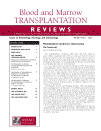Graft-versus-Host Disease: The Pesky Fly in the Ointment
by John R. Wingard, Editor
The alloreactive potency of the hematopoietic stem cell graft provides powerful anticancer activity. Unfortunately, the potential for harm (by graft-versus-host disease [GVHD]) is often as strong as the potential for good. The measures used to control GVHD, such as steroids and antithymocyte globulin, often seem like elephant guns causing similar harmful effects (toxicity and vulnerability for infection) as the GVHD itself, and they rob much of the anticancer effects of the donor graft. GVHD is indeed the thorniest problem of allogeneic hematopoietic cell transplantation (HCT). What can be done?
This issue contains a written adaptation of a symposium that addresses the topic of new strategies for GVHD. This symposium was presented at the 2007 BMT Tandem Meetings in Keystone, Colorado. Drs. Jacobsohn, Chen, and Chan describe a variety of opportunities to improve control of GVHD. As they note, the quest for GVHD control begins with donor selection. Manipulation of the conditioning regimen also holds promise. Stem cell graft engineering has taken on new life due to better understanding of how various cell populations function and interact and better techniques to characterize, isolate, and expand them by both ex vivo and in vivo tools. Finally, posttransplantation immunosuppressive regimens have historically been useful in reducing severe acute GVHD but have left unaffected chronic GVHD; now, new immunosuppressive agents are in clinical trials to test if they are more effective or provide safety advantages. Ultimately, exquisite engineering of the donor graft or staged infusions of specific cell populations may be necessary to optimize the beneficial immunotherapeutic effects of HCT. Alternatively, incremental progress in the multiple facets of the various elements of transplantation including donor selection, conditioning regimen, posttransplantation immunosuppressive regimens, and cellular engineering may get us what we need. GVHD has been the pesky fly in the ointment of HCT.
For an ointment to be truly a healing unguent, impurities must not deter its use; for HCT to be more widely applied for human disease, serious complications such as GVHD must be better controlled.
Download a PDF version of the full issue.

